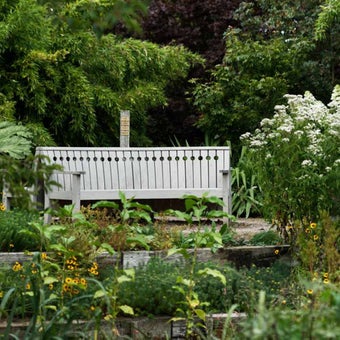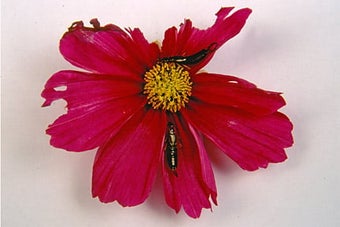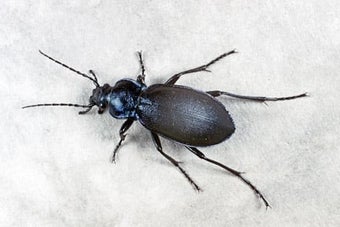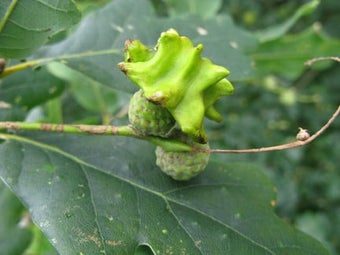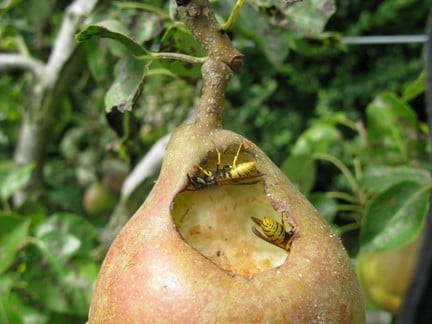
Quick facts
Common names - Wasps (social) and European hornet
Scientific names - Vespula species,Dolichovespula species and Vespa crabro
Plants affected - Ripe fruits, including grapes, pear, plum and apple
Main cause - Social wasps
Timing - May-October
What are social wasps?
'Wasps' can describe many 1000s of species including the predatory solitary and parasitoid wasps. Wasps are a vital part of the that healthy gardens support.
Social wasps live in colonies and in Britain are usually yellow and reddish brown or black. These are known as 'yellowjackets' in some parts of the world and have many other common names.
Seven species of social wasps commonly occur in gardens in Britain. Short cheeked, Vespula species of wasps, such as the common wasp (V. vulgaris) red wasp (V. rufa) and German wasp (V. germanica) usually make their nests underground or in dark cavities, such as roof spaces. Long cheeked, Dolichovespula species of wasp, such as the median wasp (D. media), Saxon wasp (D. saxonica) and tree wasp (D. sylvestris) usually make their nests in open air situations, such as on the outside of a building or among the branches of a tree or shrub.
The hornet (Vespa crabro) is Britain’s largest social wasp and it appears to have become more common in recent decades. Although its size can cause alarm it uses its sting less often than other species of social wasp.
It is a useful garden predator and will predate on other species of wasp. It usually nests in rot holes in trees and other dark cavities.
Another species of hornet, the Yellow-legged hornet (Vespa velutina also known as the Asian hornet) has become established in France and some other areas of mainland Europe. The Yellow-legged hornet is smaller than the European hornet and has only one yellow stripe on its abdomen whereas the hornet has several yellow stripes. More information including an identification guide can be found at the non native secretariat. Anyone who believes they have found a Yellow-legged hornet or nest should not go near it and report it here. The Yellow-legged hornet should not be confused with similar looking insects including the European hornet which is a useful predator of other invertebrates including other social wasps.
Between 2016 and 2022 twelve nests of the Yellow-legged hornet were found and destroyed in mainland Britain, all from Southern England. There were also a small number of confirmed sightings of individual Yellow-legged hornets. Updates are provided by DEFRA here, confirmed sightings are predominantly from Kent and East Sussex. It established in the Channel Islands but eradication attempts in England are currently thought to be successful.

Symptoms
The presence of a social wasp nest can be recognised by a steady stream of yellow and black-striped (ginger in the case of European hornet) insects flying to or from the nest entrance. Adult worker social wasps are about 15mm long but smaller individuals can occur, particularly in late spring. Queen wasps are larger and are 20-25mm long. Hornet workers can reach 25 mm long and queens 30mm. Social wasps are more slender and less hairy than bumblebees, which may also nest in the ground. Honeybees and most solitary bees are also hairier than social wasps. Although nomad bees can appear superficially similar to wasps. There are also numerous species of solitary wasp in Britain, these solitary species can nest in close proximity to one another, but each female will have her own nest entrance. Solitary bees and wasps either have no sting or are very unlikely to sting. There are also many species of hoverfly that are wasp mimics.
Worker wasps feed the grubs in the nest on other invertebrates such as caterpillars and aphids, they are a vital predator and part of the of a healthy garden. This activity can reduce pest problems in gardens in early summer. Later in the summer when wasp nests have passed their peak the demand for animal protein in the nest is lessened and wasps often to seek sugary substances.
Damage to plants is limited and mainly occurs in late summer, when social wasps can feed on ripe fruit. On tough-skinned fruits, such as apple, wasps enlarge cavities that have been initiated by other animals, such as bird pecks. On fruits with softer skins, such as grapes, plums and pear, wasps can initiate the damage.
Wasps can present a hazard if a wasp nest is disturbed. For example this can happen when bins are being emptied, hedges trimmed, rough grass is being mown or when flower beds are being weeded. Wasps will defend their nest by stinging anyone or animal who is nearby. This is defensive behaviour and if left alone wasps tend not to be aggressive. NHS Advice on stings.
Worker wasps that are building the nest structure will gnaw wood fibres from wooden garden furniture, sheds and fences. This causes paler patches where the surface has been scraped off but no real damage is done.
Get involved
Join in the big wasp survey to help find out more about social wasps.
Management
Where possible wasp nests should be left alone and wasps treated as the predators and pollinators they are, they can help the natural balance in gardens by consuming other invertebrates and are a vital part of garden . The nests die out in late summer or autumn. Although never re-used the papery constructions can last several years before breaking down.
Wasp damage on fruits can be reduced by enclosing some of the fruit in bags made from muslin, nylon tights or similar fine meshed materials. Grapes in glasshouses can be protected by fixing a wasp-proof screen over the door and vents. Foraging wasps can be trapped in jam jars half-filled with water plus some jam. The top is covered with a sheet of paper held on with an elastic band. Punch a hole in the centre of the paper with a pencil to allow wasps to enter. They will be attracted by the scent of the fermenting liquid and will drown. A wide variety of wasp traps are also available from garden centres and hardware stores. It is not clear if these traps reduce wasp numbers locally or attract more wasps from further afield.
Biology
In spring, queen wasps emerge from sheltered overwintering sites and seek suitable places where they can establish nests. Initially a queen wasp is on her own and does all the nest building and food gathering (usually other insects) for the first brood of larvae. The initial queen nest is about the size of a golf ball and contains a small number of hexagonal-shaped cells in which the queen lays eggs. The larvae are white, legless maggots that pupate in their cells. Most emerge as infertile females, known as worker wasps. Once workers are available they increasingly take over the tasks of building the nest and gathering food, allowing the queen to remain in the nest and lay eggs. By late summer, a wasp nest can be larger than a football and contain 400-500 worker wasps. At that time, males and fertile females are produced, with the latter becoming next year's queens. The nests of Dolichovespula species decline and die out in late summer but those of Vespula species and the hornet can continue into late autumn. The workers, males and the old queen die at the end of the season and only the young queens overwinter. They leave the nest and seek sheltered places elsewhere, such as in outbuildings or under loose .
Wasps gather material to construct their nests by rasping wood fibres from fences, garden sheds and other suitable exposed wood. The fibres are mixed with the wasps' saliva to make a paste that can be moulded by the wasps' jaws to make the combs of hexagonal cells and the outer envelope that encloses the nest. Unlike bees, which feed their larvae with nectar and pollen, wasps are mainly predatory. The worker wasps capture other insects or feed on carrion. The food is chewed up by the worker wasps and partially digested before being regurgitated and fed to the larvae.


